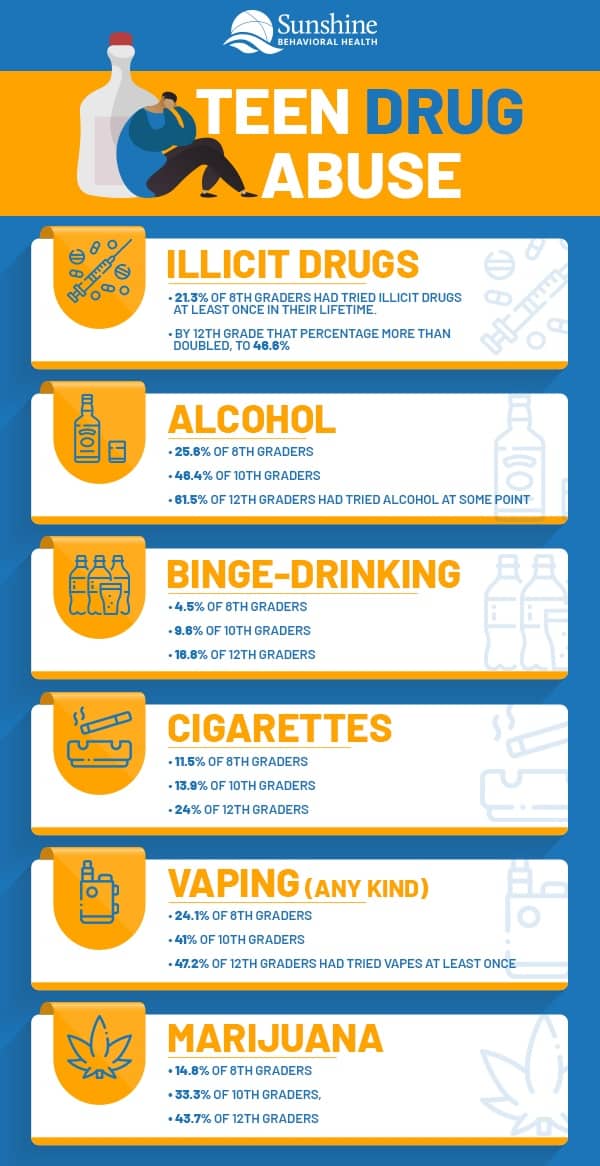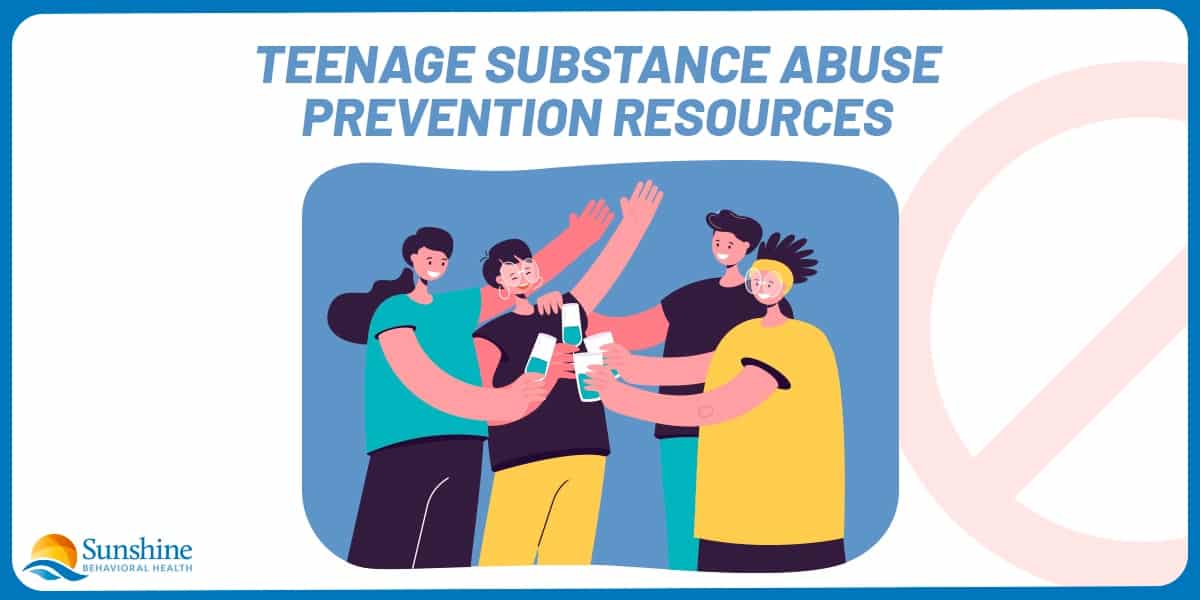Drug and alcohol abuse can be problematic for anyone at any point in their lives, but when teens partake, the risks can be greater.
That’s because drugs and alcohol present many of the same dangers adults face, but there are some perils unique to youngsters whose brains are still developing.
Data shows that teens are trying things. The Monitoring the Future Study looked at the habits of 8th, 10th, and 12th graders from 2017-2020. They analyzed lifetime activities as well as those from the past year and previous month. More statistics can be found here, but some details for 2020 alone include:
- Illicit drugs: 21.3% of 8th graders had tried illicit drugs at least once in their lifetime. By 12th grade that percentage more than doubled, to 46.6%
- Alcohol: 25.6% of 8th graders, 46.4% of 10th graders, and 61.5% of 12th graders had tried alcohol at some point. One-third of 12th graders said they’d drank in the past 30 days.
- Binge-drinking: 4.5% of 8th graders, 9.6% of 10th graders, and 16.8% of 12th graders said they’d drank five or more drinks in a row.
- Cigarettes: 11.5% of 8th graders, 13.9% of 10th graders, and 24% of 12th graders tried cigarettes at least once.
- Vaping (any kind): 24.1% of 8th graders, 41% of 10th graders, and 47.2% of 12th graders had tried vapes at least once. Nicotine and marijuana vaping numbers were slightly lower.
- Marijuana: 14.8% of 8th graders, 33.3% of 10th graders, and 43.7% of 12th graders had tried cannabis at some point in their lives.
- Other drugs (cocaine, salvia, heroin, MDMA, Ritalin, etc.): Use remained in single digits for all age groups, with amphetamines, hallucinogens, and tranquilizers being tried the most after alcohol, nicotine, vaping, and marijuana.
Which Teens Are at Greater Risk for Addiction?
No one factor guarantees a person will or will not become addicted to drugs or alcohol.
Sometimes a person tries something once and is fine; they simply aren’t interested in repeating the experience. Others might continue using, possibly spurred on by peer pressure or as a way to self-medicate (particularly in dual diagnosis cases where a teen may resort to substances to mute conditions like anxiety or depression) and it settles into a habit.
Key factors that raise the likelihood of addiction include:
- Home and family: Children and teens who live in an environment with close relatives who use alcohol or drugs, that can shape their decision-making and make them see it as more of the norm. Genetics can play a role, too. If alcoholism runs in the family, a teen may be at greater risk of following that path. (But it’s no guarantee, as each case is unique.)
- Peers and school: Friends, peers, and acquaintances may directly or indirectly pressure someone to take a drink or try that first toke. When a person struggles with schoolwork or socializing, that can make them more prone to try drugs or alcohol, too.
- Age of first use: A person can become dependent on drugs at any time, but the younger they are when they first use them, the higher the likelihood of it becoming a serious habit. It’s thought to be linked to the fact that the adolescent brain is still developing, particularly the parts governing decision-making and impulse control.
- Personal history: Mental illness, family instability, or trauma from physical or sexual abuse can lead a person to resort to drugs as a way to self-medicate.
- Method: When a person smokes or injects a drug they’ll feel its effects faster, but the effects will fade more quickly, too. That can cause them to repeat use and reinforce dependence.

Harmful Consequences of Teenage Substance Use Disorder
When teens engage in substance use disorder that behavior can present significant risks.
It can affect the brain, lead to dangerous behaviors, cause them to do poorly in school, and make it harder to stop using.
Drug and alcohol abuse primarily affects three parts of the brain:
- The brain stem: Responsible for breathing, movement, digestion, and blood circulation. Intoxication can inhibit breathing and affect coordination.
- The limbic system: Oversees pleasure and emotion. Drugs or alcohol interfere with how we enjoy rewards — making us more reliant on substances — and motivate us to seek more of the same to hold onto those good feelings.
- The cerebral cortex: This makes up the bulk of the brain. Some sections govern our senses, while others influence decision-making, planning, and problem-solving. Drugs and alcohol can make it harder to say no.
Teen brains are still forming and continue to do so into one’s early to mid-twenties. As a result drug or alcohol use can meddle with how the brain experiences pleasure and rewards. Decision-making and impulse control abilities can be affected, too.
When someone abuses drugs they put themselves at risk for any number of complications:
- Addiction, which can lead to a long list of health problems, including heart, liver, and kidney disease; many types of cancers; memory problems; and mental disorders
- Poor judgment, which can lead to dangerous or risky behaviors like driving drunk or getting into fights.
- Sexual activity, which can lead to sexually transmitted diseases and unplanned pregnancies.
- Mental health woes. Sometimes drug use can exacerbate or lead to mental illnesses like depression or anxiety. Or a mental disorder can lead to someone using drugs or alcohol to self-medicate. Those are dual diagnoses or co-occurring disorders.
- Failing grades. Some students may resort to substances when their grades are poor, but substance use can also lead to them ignoring their lessons and homework.
Drug or alcohol abuse can also lead to overdose, coma, and even death.
Preventative Measures for Teenage Substance Use Disorder
Preventing teen substance use disorder is an important and potentially life-saving step. It can take time and effort to try and steer someone away from drug and alcohol use, but in comparison to the effects of addiction, it may be the easier, safer, and cheaper route.
There’s plenty of advice on helping prevent teen drug and alcohol use, too.
Experts suggest having a calm and honest conversation, free of distractions. That includes making sure the teen is sober so their minds are clear. Dialogue tends to be a better approach, rather than a lecture Then:
- Ask your teen if they have any questions or opinions. The goal is not to judge, but to have a discussion. A calm, supportive approach tends to be more effective.
- Avoid scare tactics. It’s fine to mention reasons not to use drugs, but people tend to react better toward examples they can relate to. Discussing how drugs can affect appearance might be one approach.
- When mentioning how movies, TV, and music portray drug use, approach it realistically. Ask teens what they are taking away from portrayals. Explain how that differs from real life.
- Rehearse saying no. Practice or come up with ideas for how your teen can turn down offers of drugs or alcohol. Going in prepared tends to be easier than being caught off guard.
- Be honest about your past. If your teen asks if you’ve ever used drugs or drank in high school, be upfront about it. If you’ve always abstained, explain why. If you tried drugs, let them know what you learned about the experience.
Know the Warning Signs
Early intervention tends to be a more successful approach when trying to prevent substance use disorder from turning into a full-blown addiction.
Knowing the signs of a potential problem is a good idea. Watch out for:
- A change in friends
- Changes in sleep, school, or eating patterns
- Changes in appearance
- Exhibiting poor judgment
- A change in behavior, like breaking rules, acting withdrawn, or detachment
- Presence of paraphernalia
Other ways to prevent or stop addiction before it gets worse include knowing what your teen is doing. Experts suggest:
- Being aware of their whereabouts and knowing who your teen hangs out with.
- Setting rules and following through with the punishment.
- Keeping track of all medications in your home so you know if anything is going missing.
- Offering support. A good way to build a bond is to notice and offer praise when your teen succeeds.
- Setting an example. Drink in moderation. Use medications as prescribed. Never share drugs.
If There’s a Problem
If you catch your teen in the act or suspect drug use, here are some tips for approaching the matter.
- Have a discussion. Speak openly and honestly about the matter. Show concern rather than be judgmental.
- Focus on the behavior. Don’t paint the teen as a bad person.
- Keep connected and keep aware. Ignoring the problem or covering for bad behavior is co-dependence and hurts both the user and loved ones alike.
- If need be, seek professional help. Consult a doctor, counselor, or addiction expert.
If a substance use disorder has developed there are many approaches to achieve recovery.
Behavioral therapies work on motivation and attitudes as well as coping strategies. Family-based therapies engage the entire family to address motivation, communication, conflict resolution, and parenting skills. Medications may be prescribed, both for dealing with withdrawal as well as for underlying disorders like anxiety. Peer support and continuing care can be beneficial, too.
Sources
Medical disclaimer:
Sunshine Behavioral Health strives to help people who are facing substance abuse, addiction, mental health disorders, or a combination of these conditions. It does this by providing compassionate care and evidence-based content that addresses health, treatment, and recovery.
Licensed medical professionals review material we publish on our site. The material is not a substitute for qualified medical diagnoses, treatment, or advice. It should not be used to replace the suggestions of your personal physician or other health care professionals.






